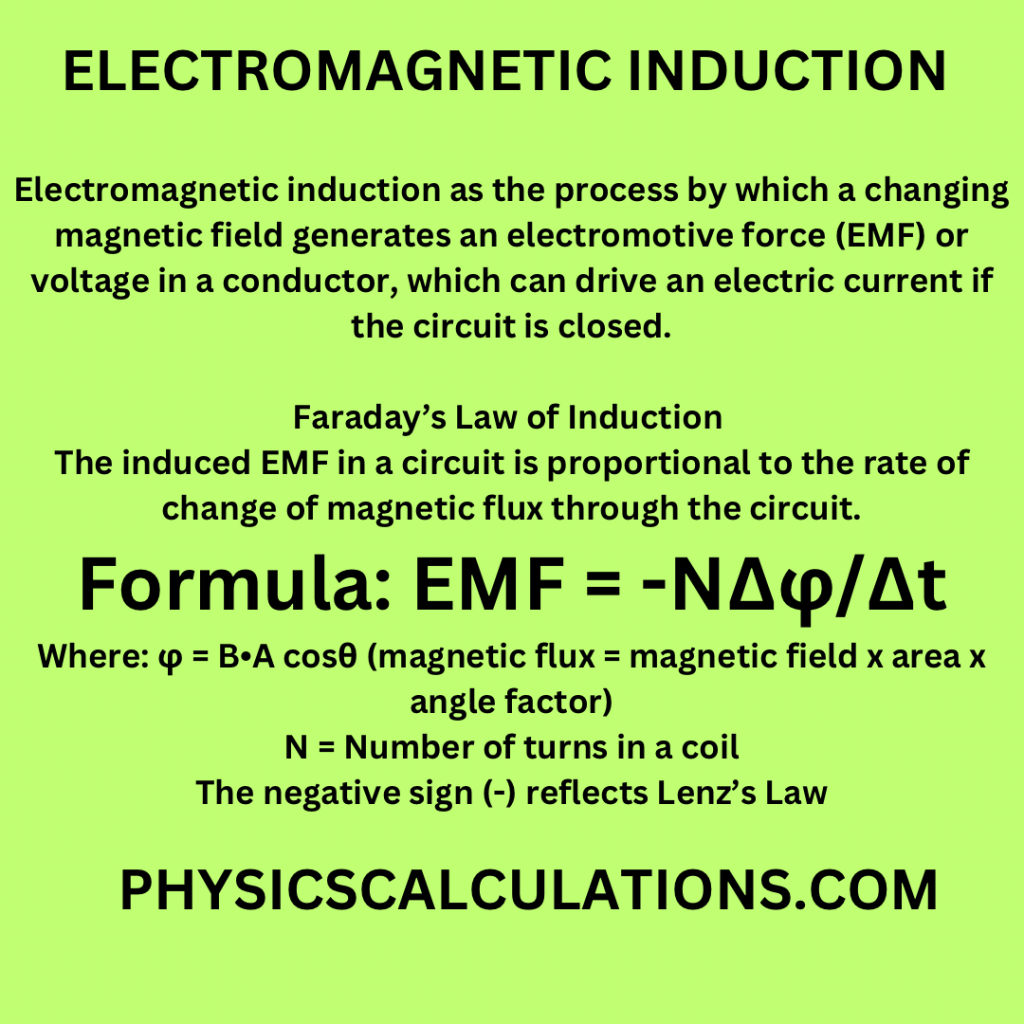Electromagnetic Induction
Electromagnetic induction is the process of generating an electromotive force (EMF) or voltage across a conductor when it is exposed to a changing magnetic field. It was first discovered by Michael Faraday in 1831. We can think of Electromagnetic induction as the process by which a changing magnetic field generates an electromotive force (EMF) or voltage in a conductor, which can drive an electric current if the circuit is closed.
Read: Magnetostriction
The Faraday’s Law
Faraday’s Law forms the bedrock of electromagnetic induction. It states that the induced emf in a circuit is directly proportional to the rate of change of magnetic flux passing through the circuit. This law lays the foundation for many electrical devices and power generation systems we use today.

Faraday’s Law of Induction
- The induced EMF in a circuit is proportional to the rate of change of magnetic flux through the circuit.
- Formula: EMF = -NΔφ/Δt
Where: φ = B•A cosθ (magnetic flux = magnetic field x area x angle factor)
N = Number of turns in a coil
The negative sign (-) reflects Lenz’s Law
Lenz’s Law
The direction of the induced current opposes the change in magnetic flux that produced it. This ensures energy conservation (For example, resisting the motion of a magnet pushed into a coil). Lenz’s Law acts as a counterforce to prevent sudden surges of current and protects circuits from damage.
How Does Electromagnetic Induction Work?
To understand the working principle of electromagnetic induction, imagine a loop of wire placed within a magnetic field. As the magnetic field strength changes, either by motion of the magnet or variations in current flowing through nearby conductors, it induces a voltage in the loop. This leads to the flow of current. Hence. this phenomenon can be related to working principles of transformers, generators, and other electrical devices.
Causes of Changing Magnetic Flux:
- Varying the magnetic field strength (for example, moving a magnet toward/away from a coil).
- Changing the area of the conductor in the field (for example, expanding or contracting a loop).
- Altering the orientation of the conductor relative to the field (for example, rotating a coil in a static field).
Applications of Electromagnetic Induction
Electromagnetic induction has many applications that led to the transformation of our modern technology. Let’s have a look at some of its most significant uses:
1. Electricity Generation
The majority of the electricity we use today is generated using electromagnetic induction. Power plants employ generators that utilize this phenomenon to convert mechanical energy into electrical energy through the rotation of conductive coils within a magnetic field.
2. Transformers
Transformers are devices that helps in power distribution systems. By using electromagnetic induction, they enable efficient transmission of electricity at different voltage levels. This helps in reducing energy loss and ensuring a steady power supply.
3. Induction Cooktops
Induction cooktops have gained popularity for their energy efficiency and safety. They use electromagnetic induction to directly heat the cookware, making the cooking process faster and more precise.
4. Wireless Charging Technology
Many modern gadgets and smartphones support wireless charging, thanks to electromagnetic induction. Charging pads generate a magnetic field that induces an electric current in the device, eliminating the need for cumbersome cables.
5. Induction Motors
Induction motors are widely used in various industrial applications. They operate based on the principles of electromagnetic induction and provide a cost-effective and reliable solution for powering machinery and equipment.
Eddy Currents
Eddy currents are loops of electrical current induced within conductive materials when exposed to a changing magnetic field. While they can cause energy losses, they also find practical applications in electromagnetic braking and induction heating.
The Role of Mutual Inductance and Self-Inductance
Mutual inductance refers to the induction of emf in one coil due to the changing current in another nearby coil. On the other hand, self-inductance occurs when the changing current in a coil induces emf within the same coil. Both phenomena play vital roles in various electrical circuits and devices.
The Impact of Electromagnetic Induction on Wireless Communication
The advent of electromagnetic induction significantly influenced wireless communication. From radio waves to Wi-Fi signals, the principles of electromagnetic induction allow the transmission of information wirelessly over a long distance.
Electromagnetic Induction in Magnetic Resonance Imaging (MRI)
Medical imaging owes a great deal to electromagnetic induction, particularly in the case of Magnetic Resonance Imaging (MRI). This non-invasive diagnostic tool uses powerful magnetic fields and radio waves to produce detailed images of the human body’s internal structures.
Electromagnetic Induction and Electromagnetic Waves
Electromagnetic induction and electromagnetic waves are closely related phenomena. Electromagnetic waves, such as light and radio waves, are produced by accelerating charges and, in turn, can induce currents in conductors they encounter.
Faraday Cages
Faraday cages are specialized enclosures that utilize the principles of electromagnetic induction to block external electric fields. They are widely used to protect sensitive equipment and devices from electromagnetic interference.
FAQs
- What is electromagnetic induction?
Electromagnetic induction is the process of generating an electromotive force (emf) or voltage across a conductor when it is exposed to a changing magnetic field.
- Who discovered electromagnetic induction?
Electromagnetic induction was first discovered by Michael Faraday in 1831.
- How is electromagnetic induction used in electricity generation?
The majority of electricity generation relies on electromagnetic induction in power plants, where generators convert mechanical energy into electrical energy.
- What are the applications of electromagnetic induction?
Electromagnetic induction finds applications in electricity generation, transformers, wireless charging, induction cooktops, induction motors, and more.
- What is Lenz’s Law in electromagnetic induction?
Lenz’s Law states that the induced current in a conductor always opposes the change that caused it.
- How does electromagnetic induction impact wireless communication?
Electromagnetic induction enables wireless communication by allowing the transmission of information through radio waves and Wi-Fi signals.